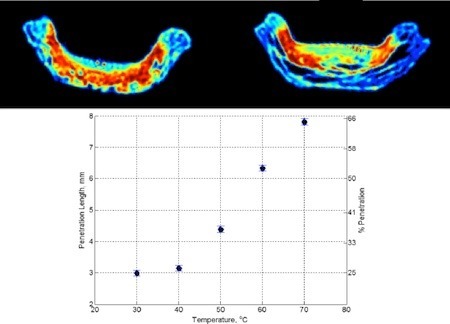Marc Abrahams's Blog, page 457
October 11, 2013
How to use your nose as a mouse
This technique for using one’s nose, described publicly in 2004, has yet to catch on in a major way:
“Nouse ‘Use your nose as a mouse’ perceptual vision technology for hands-free games and interfaces,” Dmitry O. Gorodnichy and Gerhard Roth, Image and Vision Computing, vol. 22, no. 12, 2004, pp. 931-942. The authors write:
“The described techniques for tracking a face using a convex-shape nose feature as well as for face-tracking with two off-theshelf cameras allow one to track faces robustly and precisely in both 2D and 3D with low resolution cameras. Supplemented by the mechanism for detecting multiple eye blinks, this technology provides a complete solution for building intelligent hands-free input devices. The theory behind the technology is presented…. It should be noted that the convex-shape nose feature is not associated with a physical point on a nose. Instead, it is associated with the extremum of the nose curvature, which moves on the nose surface.”
Here’s detail from the paper:

Playing a cello (inside an MRI scanner)
 Performing a quasi-real-time fMRI scan of a performing cellist presents considerable problems to researchers. Aside from the extreme lack of space, if the cello had any metallic components it could present a danger anywhere near the über magnets of an operational MRI machine.
Performing a quasi-real-time fMRI scan of a performing cellist presents considerable problems to researchers. Aside from the extreme lack of space, if the cello had any metallic components it could present a danger anywhere near the über magnets of an operational MRI machine.
Such considerations have prompted a research team from the Input Devices and Music Interaction Laboratory (IDMIL) of the Centre for Interdisciplinary Research in Music Media and Technology (CIRMMT) at the Schulich School of Music, of McGill University in the city of Montreal, Southern Canada, to devise an fMRI-compatible optically-sensed cello and miniaturised bow.
“An opto-acoustic cello has been designed to investigate the neural correlates of cello performance using functional magnetic resonance imaging (MRI). Through the design of specialized optical sensors, for the first time, we are able to synchronously capture a cellist’s acoustic performance and musical gestures within the MRI scanner.”
Researchers Avrum D. Hollinger and professor Marcelo M. Wanderley will present their project (lecture #7727) at the Optical Sensors session of the IEEE SENSORS 2013 Conference, which will be held in Baltimore, November 4th – 6th.
● The paper can be read in full here.
● The photo above shows a cellist, with the cello, inside the machine. A larger photo of the cello itself (outside an MRI machine) is available here:
NOTES: You might think that the somewhat extreme noise associated with MRI machines …
… might be distracting to a cello player who was attempting to perform inside it – future work may establish if this is a surmountable concern or not.
● Many and various other Improbable fMRI items can be found here

October 10, 2013
A Preliminary Public Health Look at Hospital Fist-Bumps
On the theory that sometimes little things help lessen problems caused by little things, comes this little paper:
“Reducing pathogen transmission in a hospital setting. Handshake verses fist bump: a pilot study,” P.A. Ghareeb, T. Bourlai, W. Dutton, W.T. McClellan, Journal of Hospital Infection, epub September 19, 2013. (Thanks to investigator Marek Hlavac for bringing this to our attention.) The authors, at West Virginia University, explain:
“Handshaking is a known vector for bacterial transmission between individuals. Handwashing has become a major initiative throughout healthcare systems to reduce transmission rates, but as many as 80% of individuals retain some disease-causing bacteria after washing. The fist bump is an alternative to the handshake that has become popular. We have determined that implementing the fist bump in the healthcare setting may further reduce bacterial transmission between healthcare providers by reducing contact time and total surface area exposed when compared with the standard handshake.”
This video documents the performance of a fist-bump in a non-hospital setting:

October 9, 2013
Particle Society of Minnesota
This week’s edition of Where Are They Now asks (but does not answer) the question: what’s up with the Particle Society of Minnesota?
The history stretches, officially, way back to the year 2000. An October 4, 2000 report by PCI (the Paint & Coatings Industry) newsletter announced:
Particle Society of Minnesota Forms
ST. PAUL, Minn. — The Particle Society of Minnesota, an organization with the mission to promote an interdisciplinary approach to particle science, is being formed in association with the Center for Interfacial Engineering at the University of Minnesota; the Engineering Research Center at the University of Florida, Gainesville; the Particle Division of the Adhesion Society; the Particle Technology Forum of the American Institute of Chemical Engineers; and the Adhesives and Sealants Council.
The Society will involve academic and industrial particle-science professionals in continuing education in this area utilizing expertise from the fields of mechanical and chemical engineering, materials science, chemistry, and physics. This organization will also bring particle-science professionals together to form networks that will support professional and career growth….
From that humble beginning, the Particle Society of Minnesota eventually grew into its current level of obscurity.
BONUS: One detective agency’s report on the Particle Society of Minnesota.

A Quick Peanut Butter Test for Alzheimer’s Disease
Peanut butter again tempts researchers who seek medical insight:
“A brief olfactory test for Alzheimer’s disease,” Jennifer J. Stamps, Linda M. Bartoshuk, Kenneth M. Heilman, Journal of the Neurological Sciences, vol. 333, 2013, pp. 19–24. (Thanks to investigator Holly Brothers for bringing this to our attention.) The authors, at the University of Florida, explain:
“Methods. Participants with probable AD [Alzheimer's Disease] (N = 18), mild cognitive impairment (MCI, N = 24), other causes of dementia (OD, N = 26) and matched controls (OC, N = 26) were tested, with closed eyes, for their ability to detect an odor, one nostril at a time. A container of 14 g of peanut butter was opened, held medially at the bottom of a 30 cm ruler, and moved up 1 cm at a time during the participants’ exhale. Upon odor detection, the distance between the subject’s nostril and container was measured.
“Results. The mean odor detection distance of AD patients’ left nostril (5.1 cm), and not their right (17.4 cm), was significantly less (F(3,90) = 22.28, p < 0.0001) than the other groups….
“Conclusion. This non-invasive and inexpensive left–right nostril odor detection test appears to be a sensitive and specific test for probable AD.”
BONUS (unrelated): “The Effects of Peanut Butter on the Rotation of the Earth“

Magnetic anti-snoring implant (patent)
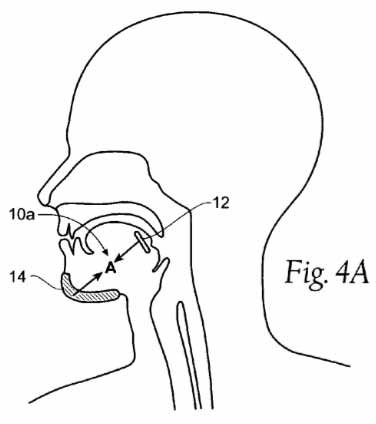 For the avoidance of snoring, and apnea in general, a new patent (August 20, 2013) has been granted to Gillis, et al. of California, US.
For the avoidance of snoring, and apnea in general, a new patent (August 20, 2013) has been granted to Gillis, et al. of California, US.
“The present invention provides devices, systems, and methods for resisting posterior movement of the tongue during sleep, thereby keeping an airway open.”
The drawing shows :
“… magnetic interaction of a ferromagnetic structure implanted in regions of a tongue with a magnetic structure carried outside an airway (e.g., on a chin and/or jaw).”
See: US 8,511,315 B2 ‘Devices, systems and methods using magnetic force systems in the upper airway.‘

October 8, 2013
Approaches to conducting a squirrel census (alt: wallabies)
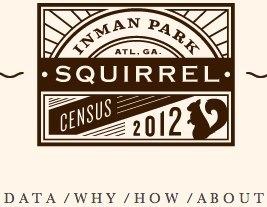 Amateur scientists in Atlanta Georgia devised their own methods for counting squirrels (thanks to investigator Amy Baxter for bringing this to our attention.) They write:
Amateur scientists in Atlanta Georgia devised their own methods for counting squirrels (thanks to investigator Amy Baxter for bringing this to our attention.) They write:
In the spring of 2012, a statistical count was made of the Eastern gray squirrel (Sciurus carolinensis) for the neighborhood of Inman Park in Atlanta, GA. The Inman Park Squirrel Census (IPSC) was managed by a part-time, unpaid staff from various professional backgrounds – two writers, two designers, a web programmer/artist, a postdoctoral research associate, a Ph.D. candidate, and a wildfire fighter. Extra volunteers assisted in the counting. The findings are presented here in a series of maps, data, and other tidbits….
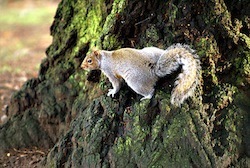 Scientists have tackled this question, and published studies that might be helpful to anyone who wants to know how to solve the problems. Here are three of those reports:
Scientists have tackled this question, and published studies that might be helpful to anyone who wants to know how to solve the problems. Here are three of those reports:
“Gray squirrel populations in extensive forested areas of West Virginia,” Hans G. Uhlig, Journal of Wildlife Management, vol. 21, no. 3, 1957, pp. 335-341.
“A comparison of methods for estimating squirrel populations,” V.F. Flyger, Journal of Wildlife Management, vol. 23, no. 2, 1959, pp. 220-223.
“Census methods for eastern gray squirrels,” Stephen H. Bouffard and Dale Hein, Journal of Wildlife Management, 1978, pp. 550-557.
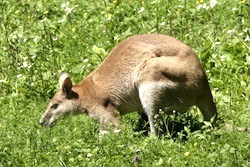
A wallaby. Photo by Nini Barbieri, creative commons.
Squirrels dwell only in some countries. Where there are no squirrels, one can perhaps find a local equivalent. Australians, for example, have wallabies. Here is one of the scientific studies about how to count wallabies:
“Methods for the census of wallaby and possum in Tasmania,” Kevin A. Johnson, Serv. Wildl. Div. Tech. Rep, vol. 77, no. 2, 1977.

October 7, 2013
Tim Poston joins LFHCfS (Hair Clubs for Scientists)
Tim Poston has joined the Luxuriant Facial Hair Club for Scientists (LFHCfS) and the Luxuriant Flowing Hair Club for Scientists (LFHCfS) [and/or possibly the Luxuriant Former Hair Club for Scientists (LFHCfS)]. He says:
I work in a startup whose flagship product photographs eyes for screening, in a country with far too few ophthalmologists: fast (no eye drops), digitally handled and analysed to detect diabetic, hypertensive, etc., problems. Mathematics has led me to many interesting places. For the The Luxuriant Flowing Hair Club for Scientists, I have attached a scanned photo of myself from forty years ago (I am also notable in the background of the top picture in the Christopher Zeeman Wikipedia page.) The other photo is for the Luxuriant Facial Hair Club for Scientists.
Tim Poston, PhD, LFHCfS
Chief Scientist
Forus Health Pte Ltd
Bangalore, Karnataka, India



President Lukashenko builds on his Ig Nobel legacy
Charter 97 reports today (October 7, 2013) that 2013 Ig Nobel Peace Prize winner Alexander Lukashenko is continuing his Ig Nobel Prize-winning ways:
Schoolchildren prohibited from clapping during end-of-harvest festival in Zhlobin
Schoolchildren had been prohibited from clapping during a parade held in Zhlobin on Friday afternoon within the framework of an annual national end-of-harvest festival called Dazhynki 2013.
During the traditional procession of the winners of a national harvesting contest, the children who greeted participants from sidewalks wore red-green jackets, waved small red-white flags but did not applaud, reported news website gazetaby.com.
General education schools in Zhlobin, a city of 75,000 residents, have been closed starting Thursday for special-task and riot police officers to live in the empty classrooms.
Alyaksandr Lukashenka is expected to be present at Dazhynki on Saturday.
On September 12, Mr. Lukashenka and the Belarusian police force were announced as Ig Nobel Prize winners at a ceremony at Harvard University’s Sanders Theater in the American city of Cambridge.
According to the website of the scientific humor magazine Annals of Improbable Research, the organizer of the Ig Nobel Prizes event, the Ig Nobel Peace Prize went to Mr. Lukashenka “for making it illegal to applaud in public, AND to the Belarus State Police, for arresting a one-armed man for applauding.”
Hundreds of people were arrested in Belarus in the summer of 2011 for merely clapping their hands to display their anger at Mr. Lukashenka’s policies. Most of them were heavily fined or jailed for up to 15 days on police court testimony that they were expressing a political opinion by clapping their hands in public.
Kanstantsin Kaplin, an unemployed man resident in Hrodna, was convicted of applauding in public and fined the equivalent of $200, despite overwhelming evidence of his innocence. He is officially registered as a disabled person and has only one arm.

MRI: tool use progresses from medicine to pork pie development
A tool often used to assess the quality of, or damage to, human bodies can also be used to assess the quality of, or damage to, an object that will be ingested into one of those human bodies. Details appear in this study:
“Magnetic Resonance Imaging: A Tool for Pork Pie Development,” Adam P. Gaunte, Robert H. Morris and Michael I. Newton [pictured here], Foods, 2013, 2(3), 393-400. (Thanks to Ben Goldacre for bringing this to our attention.) The authors, at Nottingham Trent University, UK, report:
“The traditional British pork pie consists of roughly chopped pork cooked in a hot water pastry crust. Due to shrinkage of the meat during cooking, the gap formed around the meat is usually sealed using a gelatin based jelly to exclude air and thus help to preserve the pie. The properties of the jelly are such that it will ingress into the pastry crust causing undesirable softening. The jelly is traditionally produced by simmering pig trotters with seasoning for several hours. In this work we demonstrate the potential of magnetic resonance imaging (MRI) as a tool for investigating the conditions required for producing jellies with different properties and present two examples of this use. Firstly we demonstrate that MRI can determine the ability of water to diffuse through the jelly which is critical in minimizing the amount of moisture moving from the jelly to the crust. Secondly, the impact of jelly temperature on the penetration length into the crust is investigated.”
Here’s detail from the study:
BONUS (peripherally related, but devoid of MRI use):

Marc Abrahams's Blog
- Marc Abrahams's profile
- 14 followers



